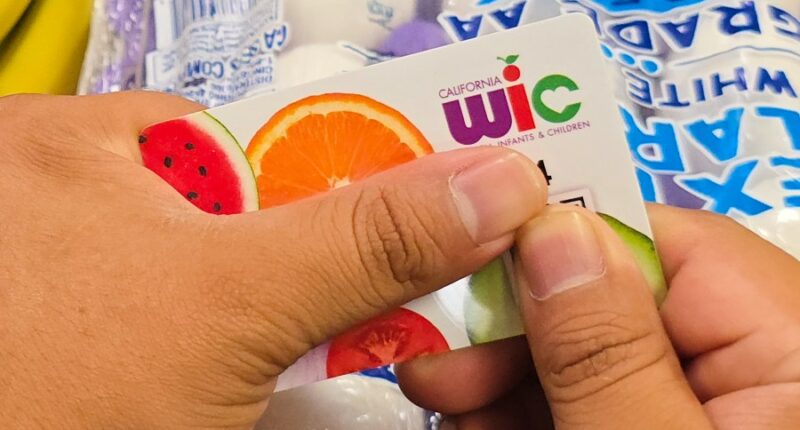Share this @internewscast.com

As the clock ticks towards Saturday, millions of Americans face the possibility of losing essential federal aid that helps them feed their families and send young children to preschool. The looming U.S. government shutdown, unless resolved, threatens to cut off funding for several vital programs that serve as lifelines for countless citizens.
One of the most significant programs under threat is the Supplemental Nutrition Assistance Program (SNAP), which assists approximately one in eight Americans with purchasing groceries. Should the shutdown continue past the weekend, SNAP benefits are expected to run out, leaving many families without financial support to put food on the table.
Moreover, other crucial services are at risk. The Head Start preschool programs, along with the Special Supplemental Nutrition Program for Women, Infants, and Children (WIC), could also see their resources depleted soon after. These programs play an essential role in providing early education and nutritional support to young children and their families.
In the absence of government intervention, the impact will be felt immediately by lower-income families dependent on SNAP. Typically, qualifying individuals receive a government-issued debit card, which is regularly reloaded to allow the purchase of groceries at approved retailers and farmers markets. The timing of these benefit renewals varies by state, although many recipients receive their recharges at the start of the month.
The potential disruption of these programs underscores the urgency for Congress to reach a resolution. Without a deal, the safety net that supports millions of vulnerable Americans may unravel, leading to widespread hardship and uncertainty.
SNAP benefits could leave millions without money for food
Lower-income families who qualify for SNAP receive debit cards loaded each month by the federal government used only for buying groceries at participating stores and farmers markets. The debit cards are recharged in slightly different ways in each state. Not everyone receives their benefits on the first day of the month, though many beneficiaries get them early in the month.
The average monthly benefit is $187 per person. Most beneficiaries have incomes at or below the poverty level.
There’s also uncertainty about whether benefits left on cards on Nov. 1 can be used. Arkansas officials suggest people who have balances on their cards should use the funds this month on shelf-stable foods. Missouri and Pennsylvania officials expect previous benefits will remain accessible and are telling beneficiaries to save for November if they can.
President Donald Trump’s administration has rejected the idea of using some $5 billion in contingency money to keep providing the federal cash for food, saying that reserve is limited to expenses such as help after disasters.
That decision contrasts with a report late last month by the U.S. Department of Agriculture that said a contingency fund could cover SNAP benefits if government funding lapsed.
Democratic lawmakers and advocacy groups have urged the Trump administration to tap into that fund to provide partial benefits into November.
Some states seeking to fill void of SNAP benefit cuts
Officials in Louisiana, Vermont and Virginia have pledged to backfill food aid for recipients even while the shutdown stalls the federal program, though state-level details haven’t been announced.
In Republican-led Louisiana, the House has voted unanimously for a resolution urging the state’s health department to use $150 million in its budget to avoid an interruption in SNAP benefits to nearly 800,000 residents. The measure awaits Senate action, and Republican Gov. Jeff Landry has said it’s a top priority.
More funding for food banks and pantries is planned in states including New Hampshire, Minnesota, California, New Mexico, Connecticut and New York, where Democratic Gov. Kathy Hochul said on Monday that she is “fast tracking” $30 million in emergency food assistance funds to help keep food pantries stocked.
Officials from some other states have said they looked into backfilling SNAP benefits with state funds but found they couldn’t because states have no way to load funds onto recipients’ cards.
Democratic Gov. Gavin Newsom of California deployed the National Guard to help his state’s food banks, though some have declined to use the troops. He is also quickly making $80 million available for food banks.
The USDA advised Friday that states won’t be reimbursed for funding the benefits.
The Trump administration is blaming Democrats, who say they will not agree to reopen the government until Republicans negotiate with them on extending expiring subsidies under the Affordable Care Act. Republicans say Democrats must first agree to reopen the government before negotiation.
Early childhood education
More than 130 Head Start preschool programs won’t receive their annual federal grants on Nov. 1 if the government remains shut down, according to the National Head Start Association.
Centers are scrambling to assess how long they can stay open, since nearly all their funding comes from federal taxpayers. Head Start provides education and child care for the nation’s neediest preschoolers. When a center is closed, families may have to miss work or school.
With new grants on hold, a half-dozen Head Start programs have already missed federal disbursements they were expecting Oct. 1 but have stayed open with fast-dwindling reserves or with help from local governments. All told, more than 65,000 seats at Head Start programs across the country could be affected.
Food aid for mothers and young children
Another food aid program supporting millions of low-income mothers and young children already received an infusion to keep the program open through the end of October, but even that money is set to run out early next month.
The Special Supplemental Nutrition Program for Women, Infants and Children helps more than 6 million low-income mothers, young children and expectant parents purchase nutritious staples such as fruits and vegetables, low-fat milk and infant formula.
The program, known as WIC, was at risk of running out of money in October because of the government shutdown, which occurred right before it was scheduled to receive its annual appropriation. The Trump administration reassigned $300 million in unspent tariff proceeds from the Department of Agriculture to keep the program afloat. But it was only enough money for a few weeks.
Now, states say they could run out of WIC money as early as Nov. 8.
___
Mattise reported from Nashville, Tennessee. AP contributors include Moriah Balingit in Portland, Oregon; Geoff Mulvihill in Haddonfield, New Jersey; David Collins in Hartford, Connecticut; Steve Karnowski in Minneapolis; Anthony Izaguirre in Albany, New York; Susan Montoya Bryan in Albuquerque, New Mexico; Sara Cline in Baton Rouge, Louisiana; and Sophie Austin in Sacramento, California.
















